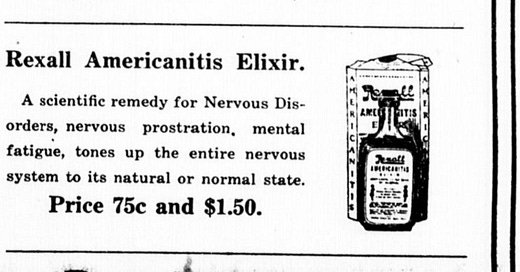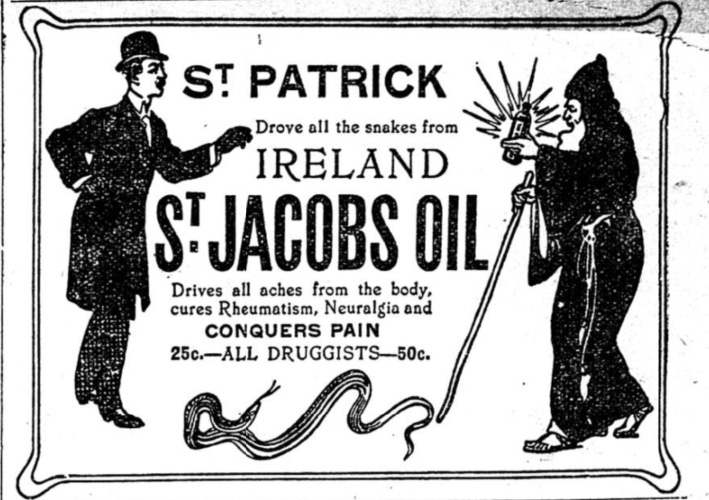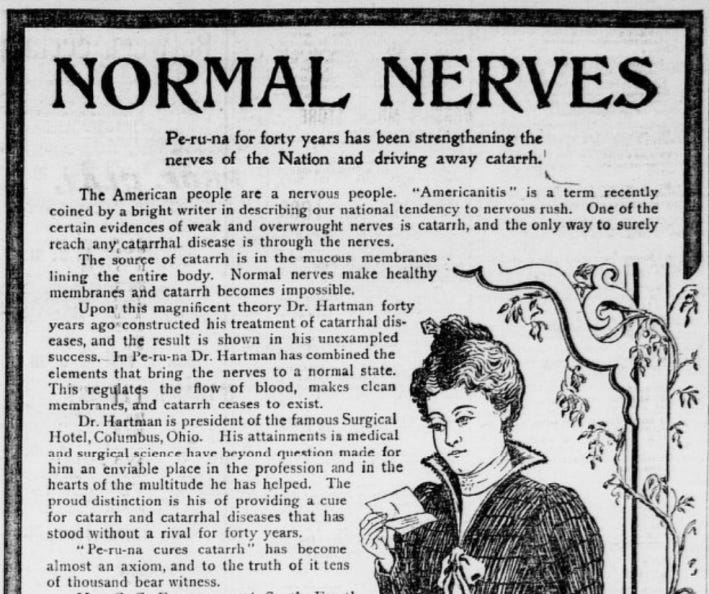A History of 'Americanitis,' the Nervous Condition That Comes With Living in America
Over a century ago, 'Americanitis' plagued a subset of the country. We're still afflicted today.

How are feeling lately? Tired? Overworkedxious? Me too. It would be natural to think that such a condition is a sign of this modern era—and in particular a symptom of the last 18 months, 5ish years, or past several decades—but actually humans have been feeling this way for over a century. Specifically, Americans have been feeling this way for over a century. In fact, Americans were feeling these feelings so intensely around the turn of the 20th century, that a central idea coalesced around them—an idea that life in the U.S. itself was to blame. The idea was so pervasive that it started to go by a single name: Americanitis.
The exact origins of the term “Americanitis” are a bit unclear, but the affliction was considered to be an extension of neurasthenia. That term was popularized by neurologist George Beard, who wrote an 1881 book called American Nervousness, which purported that humans have a limited natural supply of nervous energy, and that life in America was depleting it. The fast-paced hustle and bustle of urban life, industrialization, a population boom, and encroaching technology and noise levels were all to blame for a society that was overworked, underslept, and brimming with “excessive nervous tension.” As writer Elbert Hubbard succinctly put it, Americanitis was the result of “an intense desire to ‘git thar’ and an awful feeling that you cannot.”
Americanitis wasn’t just seen as a form of mental illness or a nervous condition, it was cited as a cause of adverse physical health effects including worsening eyesight, dizziness, headaches, impotence, lack of motivation, aches and pains, weight loss, high blood pressure, heart attack, fainting, irritability, depression, insanity, and somehow, both insomnia and fatigue. Neurasthenia was even used as the diagnosis for World War I soldiers who were suffering from PTSD. If it seems like it was used as a bit of an all-encompassing culprit, it was. Famous victims included Theodore Roosevelt, Virginia Woolf, Marcel Proust, writer Charlotte Perkins Gilman, magnate Nelson Morris, activist Jane Addams, and philosopher and psychologist William James. Those well-known sufferers were in addition to the 240,000 people who reportedly died from neurasthenia annually back in the 1920s.
As you can imagine, as soon as Americanitis was given a name, countless snake oil antidotes slithered into the marketplace. Remedies included everything from electrotherapy to reclining chairs, and a whole slew of elixirs (one contained 15 percent alcohol and some chloroform for good measure, while others contained opiates or cannabis). For some context, I looked through dozens of newspapers from this era, and they are chock-full of ads for all kinds of cures for what ails you, even if what ails you isn't specifically Americanitis. There's pills, potions, powders and creams galore.
Here's my favorite one:
Let us also not forget that this was the era of the dawn of Coca Cola—which originated as a tonic containing cocaine as well as caffeine—and Corn Flakes, which was marketed as a cure for masturbation and a means to achieve dietary purity, whatever that is. In 2021, it often feels like we're living in a particularly bad age of pricey wellness bullshit, but it really is a time-honored tradition in this country. The scam of turning these problems (some simply the byproducts of being alive, some very real mental and physical health issues, some a direct result of a failed social system) into consumer goods has been at work since time immemorial. First you name it, then you commodify it.
Outside of the free market, treatments for Americanitis included simply getting out of the house, walking, play and recreation, relaxing the muscles, relieving yourself of tasks, eating more slowly, taking naps, eating more fruits and vegetables, oh and simply stop worrying. Naturally, there were vastly different treatments for men and women, both in causes and remedies, and always with an aim to uphold traditional gender roles. Men were told to get out into the wilderness, while women were told to go to bed.
Americanitis wasn't just a trend with misogynistic undertones, it was classist and racist too. In the same way that we now have a pathological loyalty to the grind, Americanitis had a certain desirability. In his book Neurasthenic Nation, historian David Schuster writes, "Beard argued it indicated the presence of an active mind, a competitive character, a lover of liberty—in short, the quintessential American." It was patriotic to experience burnout. It was also a condition of the privileged and the white.
Despite its name, Americanitis wasn't and isn't actually a strictly American ailment. A decade ago, Evan Osnos wrote in The New Yorker about how the concept of Americanitis had reverberations in China—another country suffering from rapid industrialization and pervasive mental health stigmas. There was also Newyorkitis back in the day, which was essentially a particularly acute case of Americanitis and frankly, probably still applies today.
Concern over Americanitis and neurasthenia faded as the 20th century marched on, and was nearly gone by the Great Depression, in part because people were unemployed and had anxieties outside of being overworked and hurried. (Barbara Ehrenreich has also posited that a decline in Calvinist thought and the rise of positive thinking might have had an effect.) Still, even though we don't call it "Americanitis" anymore, the concerns over the ill-effects of American life have remained fairly constant. In 2021, on the other side of a pandemic that radically transformed our lives and our views of work, we find ourselves in a similar era of reexamining the way we live and reevaluating the limits of economic prosperity. People are out of work, quitting work, wanting to work less, be less busy, stay at home, and keep some of those things we “gained” this year. We are focused on self-care, we're buying the modern equivalent of elixirs and tonics. But are we perhaps better poised now—more engaged in dismantling the mechanisms of our melancholy—for actual change? Time will tell.
Despite being a country founded on a principle of "life, liberty and the pursuit of happiness," America never tops the United Nations' World Happiness Report. It ranked #14 in the 2021 report. As we seek hygge and read self-help books, other countries (often in Northern Europe) find happiness through balanced lives with ample social support systems and a reliable government, on top of material comforts and a properly calibrated sense of expectation around happiness. According to The Atlantic:
For the people who come up with policies and run countries, the lessons of the report are not shocking: People are more satisfied with their lives when they have a comfortable standard of living, a supportive social network, good health, the latitude to choose their course in life, and a government they trust. The highest echelon of happy countries also tends to have universal health care, ample paid vacation time, and affordable child care.
In 1899, poet Edwin Markham wrote a piece for the New York Journal headlined "AMERICANITIS—THE NATIONAL DISEASE" with subheads that read, "Do We Utterly Lack the Power of Repose?" and "Consequences of the Pursuit of Wealth." I recommend reading the entire piece, but the end in particular really hit me:
Now another thing needed by both employer and employed is more time for recreation, more time for thought. They need to have more time for meals; need to have fewer hours for work. I make a proposal to the business men of America that they reduce their business hours to banking hours; make them extend from ten to three, or from seven in the morning to twelve o'clock noon. This gives time enough for the people to supply their needs; and the business world would transact the same volume of business. This would give both master and servant time for study, time for thought, time for rest. And it would help also to ward off diseases and to increase the life and health of the people—increase their joy, their power, and their repose.
Of course the whirlwind forces let loose by the competitive system have their deadly share in the nervous waste of our civilizations. But of this phase I cannot speak at this time. I have tried to make one thing clear—that the mission of man to the world is not to make a fortune, but to make a life.
I hope you're lucky enough to have some time this weekend to make a life. We'll get back to work next week tearing all this down.
This post is part of Discourse University, an occasional series where we tackle history, ideas, and any other wonky kind of thing that strikes our fancy.









